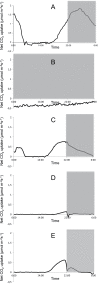Light quality modulates metabolic synchronization over the diel phases of crassulacean acid metabolism
- PMID: 24803500
- PMCID: PMC4085966
- DOI: 10.1093/jxb/eru185
Light quality modulates metabolic synchronization over the diel phases of crassulacean acid metabolism
Abstract
Temporal compartmentation of carboxylation processes is a defining feature of crassulacean acid metabolism and involves circadian control of key metabolic and transport steps that regulate the supply and demand for carbon over a 24h cycle. Recent insights on the molecular workings of the circadian clock and its connection with environmental inputs raise new questions on the importance of light quality and, by analogy, certain photoreceptors for synchronizing the metabolic components of CAM. The present work tested the hypothesis that optimal coupling of stomatal conductance, net CO2 uptake, and the reciprocal turnover of carbohydrates and organic acids over the diel CAM cycle requires both blue and red light input signals. Contrasting monochromatic wavelengths of blue, green, and red light (i.e. 475, 530, 630nm) with low fluence rates (10 μmol m(-2) s(-1)) were administered for 16 hours each diel cycle for a total treatment time of 48 hours to the obligate CAM bromeliad, Aechmea 'Maya'. Of the light treatments imposed, low-fluence blue light was a key determinant in regulating stomatal responses, organic acid mobilization from the vacuole, and daytime decarboxylation. However, the reciprocal relationship between starch and organic acid turnover that is typical for CAM was uncoupled under low-fluence blue light. Under low-fluence red or green light, the diel turnover of storage carbohydrates was orchestrated in line with the requirements of CAM, but a consistent delay in acid consumption at dawn compared with plants under white or low-fluence blue light was noted. Consistent with the acknowledged influences of both red and blue light as input signals for the circadian clock, the data stress the importance of both red and blue-light signalling pathways for synchronizing the metabolic and physiological components of CAM over the day/night cycle.
Keywords: CAM; PEPC; PEPCK; carbohydrate; gas exchange; light quality; titratable acidity..
© The Author 2014. Published by Oxford University Press on behalf of the Society for Experimental Biology.
Figures





References
-
- Antony E, Taybi T, Courbot M, Mugford S, Smith JAC, Borland AM. 2008. Cloning, localisation and expression analysis of vacuolar sugar transporters in the CAM plant Ananas comosus (pineapple). Journal of Experimental Botany 59, 1895–1908 - PubMed
-
- Benzing DH. 2000. Bromeliaceae-Profile of an adaptive radiation. Cambridge: Cambridge University Press
-
- Borland AM, Griffiths H. 1997. A comparative study on the regulation of C3 and C4 carboxylation processes in the constitutive crassulacean acid metabolism (CAM) plant Kalanchoë daigremontiana and the C3-CAM intermediate Clusia minor . Planta 201, 368–378 - PubMed
Publication types
MeSH terms
Substances
LinkOut - more resources
Full Text Sources
Other Literature Sources

